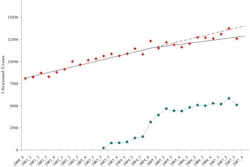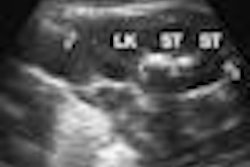Contrast-enhanced ultrasound is more accurate than MRI and CT for characterizing focal liver lesions, according to a multicenter international study.
Researchers led by Dr. Hervé Trillaud, Ph.D., from the University of Victor Segalen Bordeaux 2 in France, examined patients with focal liver lesions detected on baseline ultrasound. They compared the accuracy of conventional ultrasound for characterizing lesions with that of contrast-enhanced ultrasound, contrast-enhanced CT, and dynamic contrast-enhanced MRI. Their results were published in the World Journal of Gastroenterology (August 14, 2009, Vol. 15:30, pp. 3748-3756).
The study population included 127 patients (54 men and 73 women, mean age 54.8 years, range of 19-93 years) who were examined at nine European centers (five in France, two in the Czech Republic, one in Belgium, and one in Poland).
After baseline ultrasound, patients received at least two bolus injections of ultrasound contrast (SonoVue, Bracco, Milan, Italy), one for detecting the focal lesion and another for detecting additional lesions. All patients also received at least one triple-phase contrast-enhanced reference exam with CT or MRI, with single-slice CT (37/127 patients), multislice CT (78/127 patients), and dynamic MRI (70/127 patients) scans performed.
After four patients were excluded, researchers were left with 123 patients in the final population, with 68 benign focal liver lesions and 55 malignant ones. Sensitivity, specificity, and accuracy of both ultrasound techniques were compared to combined CT/MRI studies, with the following results:
Correct classifications of malignant lesions
|
The researchers reported four adverse events, three of which were mild (pain or rash at the injection site) and one with moderate intensity (nausea).
Second-generation contrast agents such as SonoVue can assess intratumoral vascularity and dynamic enhancement patterns comparable to information obtained with CT and MRI, the researchers concluded. Contrast-enhanced ultrasound is superior to CT and MRI due to its lack of radiation, exposure to nephrotoxic contrast media, and large installed base of ultrasound machines with which the technique can be performed.
Contrast-enhanced ultrasound can be used as the first-line exam for characterizing focal liver lesions, followed by CT or MRI, or histological confirmation if needed, they said.
Related Reading
Interest grows in noncardiac ultrasound contrast applications, May 21, 2009
CEUS of focal liver lesions in the noncirrhotic liver, May 19, 2009
Contrast ultrasound beats CT, PET in Hodgkin's lymphoma staging, May 6, 2009
Bracco revisits plans for U.S. launch of SonoVue, March 8, 2009
CEUS shines in complex cystic renal masses, October 3, 2008
Copyright © 2009 AuntMinnie.com



















